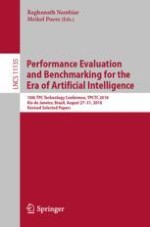2019 | Book
Performance Evaluation and Benchmarking for the Era of Artificial Intelligence
10th TPC Technology Conference, TPCTC 2018, Rio de Janeiro, Brazil, August 27–31, 2018, Revised Selected Papers
Editors: Raghunath Nambiar, Meikel Poess
Publisher: Springer International Publishing
Book Series : Lecture Notes in Computer Science
